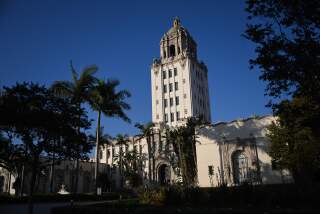Robinsons-May Beverly Hills: A shopping icon that may drop
Lost L.A. unearths something that’s buried in history. It tells stories of buildings that have been razed, burned or renovated into extinction. Developers often cause these wipeouts, explaining them away as the price of progress. Translation: the cost of greed.
The progress of profit is on the move again, but this time you can see the victim -- the former Robinsons-May building in Beverly Hills -- before it’s rubble.
In 1883, J.W. Robinson’s opened in downtown L.A., bringing west the tradition of the American department store that began in New York. These early emporiums were democratic and efficient. From their racks and open shelves, bankers’ wives and modest secretaries could dress themselves and their houses, all in an afternoon.
For years Robinson’s executives resisted suburban expansion. That changed after World War II, when 3,000 people a day poured into L.A. and developers slapped up houses on cheap, open lots. Robinson’s tested the waters with a shop in the Beverly Hills store of MGM costume designer Gilbert Adrian. In 1950, management took the plunge, committing to build more than 200,000 square feet at 9900 Wilshire Blvd.
Robinson’s entrusted its new store -- and $6 million -- to celebrated designers. The architect-engineers were Charles O. Matcham, Charles Luckman and William Pereira, an L.A. star whose career led to the Transamerica Pyramid in San Francisco, the now-mangled Los Angeles County Museum of Art complex and CBS’ Television City. Raymond Loewy and Associates, designers of the Lucky Strike logo, the Sears Coldspot refrigerator and the Greyhound bus, did the interiors. For the landscaping of almost 8 acres, Florence Yoch and Lucile Council were on hand. They had designed gardens for “Gone With the Wind” and the grounds of Jack Warner’s estate, today David Geffen’s.
When Robinson’s Beverly Hills opened on Feb. 13, 1952, it celebrated the progress of invention. Curious shoppers parked their Chevys and Fords in an 1,100-space lot. They walked through glass doors in the low, marble building and discovered a shining new world that combined, as The Times reported, “striking architecture and sophisticated smartness.”
Old-line department stores had been cluttered. This Robinson’s was open and spacious, with four levels connected by “vertical transportation,” two escalators and two elevators. Loewy explained that “free flow traffic” made for easy “arcade shopping.” There were yard goods, children’s clothes, Adrian’s boutique and Robinaire, a shop for budget dresses. At the top was the Pink Tent for lunch.
The home furnishings department was on the “garden level.” It was the highlight of the store, a boutique with a living-room feel.
Floor-to-ceiling windows looked out on a California patio. Instead of department store counters and wood floors, there were streamlined cabinets and wall-to-wall carpeting. The Loewy firm was proud of the tables illuminating imported cut crystal, porcelain figurines and plates. It had used modern design to make the traditional look new.
The message to the decorator-housewife: You too can belong to the future.
For more than 50 years Robinson’s was the neighborhood store, with architect Welton Becket’s 1953 Beverly Hilton hotel across the street. Shopping and lunch before picking up the kids at school was a tradition until 2006, when management closed the store, by then known as Robinsons-May.
In 2007, the planning and resources management firm Jones & Stokes Associates determined that the place that launched decentralized shopping in America was eligible for the California Register of significant sites. But the fate of 9900 Wilshire was already in the hands of developers.
First, there was New Pacific Realty, which paid Getty Center architect Richard Meier to design a green hotel and condo complex with private and public gardens. New Pacific, which paid $33.5 million for the site, issued a statement that said its development, requiring the demolition of the historic 1952 department store, would reflect “the standards and values of Beverly Hills throughout the world,” according to a story in The Times.
Next up were Christian and Nicholas Candy, thirtysomething British developers of condos for the Euro rich. They picked up the property and Meier’s plans for $500 million from New Pacific. The brothers’ Iceland banking partner collapsed in the global financial crisis, and a request this week for Candy & Candy to update The Times on the future of the development went unanswered. Zoning variances and permits, however, supported by enthusiastic city officials, authorize construction to begin after a nearby school is out.
So get in your Prius and drive on over to 9900 Wilshire. Seize this opportunity to see a part of your present before progress makes it part of your past.
Watters is author of “Los Angeles Houses, 1885-1935.”
His columns are archived at latimes.com/lostla.
More to Read
Sign up for Essential California
The most important California stories and recommendations in your inbox every morning.
You may occasionally receive promotional content from the Los Angeles Times.










